Anatomy of a Song: "Losing My Mind"
"... by touching the lives and feelings of ordinary people.” This quote from Gavin Bryars points to his mission as a composer, and is revealed through some of his new music for piano.
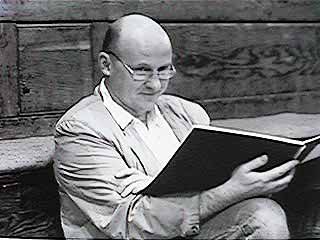 via www.gavinbryars.comYou won’t find much in Gavin Bryars’ new Piano Concerto that is harsh to the ears. The stereotypical avant-garde music of the 20th and 21st Centuries is far removed from the music on the new Naxos release of Bryars’ Piano Concerto (The Solway Canal), After Handel’s Vespers and Ramble on Cortona.
via www.gavinbryars.comYou won’t find much in Gavin Bryars’ new Piano Concerto that is harsh to the ears. The stereotypical avant-garde music of the 20th and 21st Centuries is far removed from the music on the new Naxos release of Bryars’ Piano Concerto (The Solway Canal), After Handel’s Vespers and Ramble on Cortona.
The British composer is perhaps best known for his pieces The Sinking of the Titanic and Jesus Blood Never Failed Me Yet. Both were written for atypical ensembles, including tape and other electronics, and were first recorded on Brian Eno’s record label in the 1970s. (They have since been revised and rerecorded). It’s telling that his early music was released on Eno’s record label; it’s not ambient music, but Bryars’ music has a familial relationship with it. Bryars’ was a student of John Cage and his compositions place him near the better known Gorecki and Pärt on the musical family tree. Here, Bryars looks to more traditional ensembles and forms on one of the finer classical music releases of the first part of 2011.
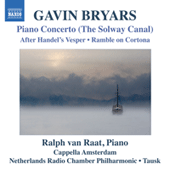 via www.naxos.comThe Piano Concerto is not one that features technical flair and drama. An audience won’t instinctively leap to its feet as they would at the end of a Rachmaninov concerto. But that doesn’t make it any less intriguing or enjoyable. What you’ll hear, instead, is a nearly 30-minute piece for piano, men’s chorus and orchestra that borders between impressionistic and post-minimalist styles, full of dark, evocative sounds and subtlety. The piano serves as a mentor to the ensemble, guiding and handing off material to the orchestra, rather than forcing them to serve a more subservient role as in more traditional concerti.
via www.naxos.comThe Piano Concerto is not one that features technical flair and drama. An audience won’t instinctively leap to its feet as they would at the end of a Rachmaninov concerto. But that doesn’t make it any less intriguing or enjoyable. What you’ll hear, instead, is a nearly 30-minute piece for piano, men’s chorus and orchestra that borders between impressionistic and post-minimalist styles, full of dark, evocative sounds and subtlety. The piano serves as a mentor to the ensemble, guiding and handing off material to the orchestra, rather than forcing them to serve a more subservient role as in more traditional concerti.
The piece opens simply enough, with open 5ths played by the orchestra and piano, but soon the tonal center shifts around, never quite leaving A minor and C major, but never quite settling on it, either. Chromaticism recurs through the piece, often on the outlying edges of the score, but never intrudes enough for the piece to lose its tonal feel. The imagery of the sonnets by Scottish poet Edwin Morgan and the haunting quality of the men’s chorus are unusual in the context of a piano concerto, but suit this piece and Bryars’ compositional style well. This is an unobtrusive piece, whose beauty lies in its simplicity. It’s the first glimpse of a flower bud underneath the snow of a long winter.
The opening pieces on the album are for solo piano. After Handel’s Vespers was originally written for the harpsichord, and translates well to the piano. Ramble on Cortona is Bryars’ first work for solo piano, the dedicatee, like the Piano Concerto, being pianist van Raat. Both works acknowledge earlier music – Vespers from the 17th and 18th Centuries, Ramble from the 13th Century – but take full advantage of the piano’s sonorities and the capabilities of a contemporary composer. As Bryars has said, “one of the challenges I enjoy is writing in the light of history … I take great sustenance from the music of the past.” He has the ability to reference and incorporate earlier styles without losing his own voice.
The performances by piano soloist Ralph van Raat, the Netherlands Radio Chamber Philharmonic and the men of the Capella Amsterdam suit the music well. Raat has a touch that brings out the lyrical qualities of Bryars’ music, and the Philharmonic lingers on every note in the Piano Concerto until the last possible minute, absorbing themselves and the listener in the moments at hand.
Kudos to Naxos for this fine album, and for continuing to release new music. The label has long moved from simply being a clearinghouse of “budget classical” records made by Eastern European musicians to one of the foremost record labels for new and previously unrecorded classical music.
The above video was the opening of my senior piano recital at UW-Eau Claire, on 10 November 2003. It is a Bach Prelude and Fugue originally written for organ, published in Eight Little Preludes and Fugues, and transcribed for the piano by Dmitri Kabalevsky. I made the YouTube video (and this blog post) to celebrate Bach’s birthday on March 21st, and the corresponding #BachChat discussions on Twitter.
Below are the program notes I wrote for my senior recital:
Johann Sebastian Bach wrote most of his organ music while organist at the court of the Duke of Weimar, between the years of 1708 and 1717. Is is during this time that the Prelude and Fugue in D minor, BWV 554, was most likely written. As is often the case with Bach's Preludes and Fugues, this work share similarities with the D minor Prelude and Fugue from each book of the Well-Tempered Clavier as well as the D minor Invention and Sinfonia.
The Prelude is rather gloomy, and is in ABA form. The powerful chords of the opening statement contrast rather nicely with the B section, which is marked by a near steady stream of sixteenth notes. The fugue is simple by Bach's standards; the subject and answers are very clearly organized, and there are no stretto statements. The fugue is one large crescendo, ending with the subject stated in D minor. Originally written for the organ, the transcription played today was made by the great Russian composer Dmitri Kabalevsky.
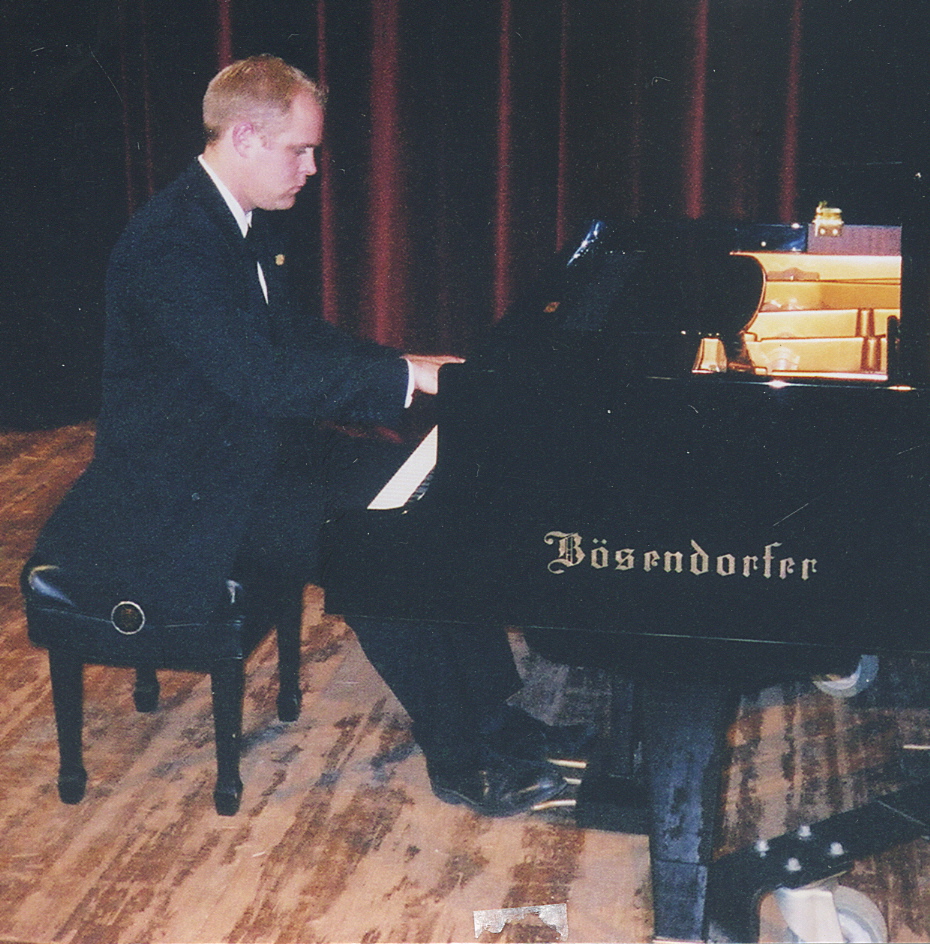 Senior Recital, UW-Eau Claire, 10 November 2003
Senior Recital, UW-Eau Claire, 10 November 2003
In the Spring of 2003 I had an independent study that focused on JS Bach's Goldberg Variations. In anticipation of Bach's birthday in March, and to contribute a little to the #BachChat discussions on Twitter, I will be posting some items from my final paper.
Part of my project was interviewing several people deeply connected with the Goldberg Variations. Below is an interview conducted, via mail, with Dr Rosalyn Tureck. It was done in March, 2003, three months before Dr Tureck passed away.
I have annotated the interview to clarify some points. These annotations are from 2003, and can be found at the bottom of this post (via the numbers in brackets, ie [3]).
I haven't read this interview since probably 2004, and I'm just as intrigued by her answers today as I was then. I hope you feel a similar way. Please share your thoughts and comments on the interview below.
There are several YouTube videos of Dr Tureck playing the Goldberg Variations, but some of the best cannot be embedded. They are available here - from shortly before her death - and here - from 1995.
___________________________________________
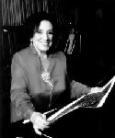 via www.discogs.comRosalyn Tureck is known as one of the foremost J.S. Bach scholars and performers in the world. Born in Chicago in 1914, she first performed the Goldberg Variations from memory at the age of 23. In addition to performing Bach, Dr. Tureck has focused on pieces by 20th-century composers, although her repertoire has covered every major composer. Additionally, she studied with Léon Thérémin in her teens, made her Carnegie Hall debut, at the age of 17, on a Thérémin instrument, and has performed on various electronic instruments. She has recorded and performed the complete Goldberg Variations numerous times. Dr. Tureck founded the Tureck Bach Institute in New York City in 1967, and in 1993 she founded the Tureck Bach Research Foundation, based in Oxford, England. Dr Tureck passed away on July 17, 2003. [1]
via www.discogs.comRosalyn Tureck is known as one of the foremost J.S. Bach scholars and performers in the world. Born in Chicago in 1914, she first performed the Goldberg Variations from memory at the age of 23. In addition to performing Bach, Dr. Tureck has focused on pieces by 20th-century composers, although her repertoire has covered every major composer. Additionally, she studied with Léon Thérémin in her teens, made her Carnegie Hall debut, at the age of 17, on a Thérémin instrument, and has performed on various electronic instruments. She has recorded and performed the complete Goldberg Variations numerous times. Dr. Tureck founded the Tureck Bach Institute in New York City in 1967, and in 1993 she founded the Tureck Bach Research Foundation, based in Oxford, England. Dr Tureck passed away on July 17, 2003. [1]
___________________________________________
Knowing that you have performed Bach since a youth, has your interest in Bach ever waned?
No.
Can you explain what new technique you developed in studying and performing Bach’s music? Do you feel that the focus on structure, although hindering the time it took to learn a piece, ever hindered your performance abilities, or have you always seen it as a positive thing? [2]
It helped and never hindered me; I’d learn a new fugue by memory in 20 minutes. [3]
You’ve recorded the Goldberg Variations numerous times. Have you approached them differently each time, applying new scholarly information? What approach do you take with the Goldberg Variations when you record or perform them – do you try for something different than you’ve done in the past?
I don’t try – I study and I grow.
Many artists, including Leonard Bernstein and Glenn Gould, are known for rerecording pieces at slower tempi and with different interpretations as they age, saying that they are searching to bring more of the music out. Have you experienced this phenomenon as well? Do you listen to your previous recordings and think of things that you would have changed if you had the chance, or do you see them as an image of who you were at that time?
I do not search for new interpretations. They grow and grow in scholarship and artistic insight.
The last fifty years or so has seen an increase in scholarly output concerning performance practices of all music periods. You have been a part of this, becoming an expert on period instruments and practices. What do you feel about the debate concerning Bach and his keyboard music: if it’s meant for the harpsichord or piano, what ornamentations are proper, what tempi and dynamics to use, etc.? [4]
András Schiff and Vladimir Feltsman are known for their attempts to emulate the harpsichord in their performances and recordings of the Goldberg Variations by changing octaves on the repeats in the variations. Have you considered this? Do you see it as an accurate representation of what a harpsichordist would do in a performance?
No, it is not. The idea is naïve. It is not appropriate to try to imitate the harpsichord on the piano. This subject is deeper than they are perceiving.
You are known as the “high priestess of Bach,” but you also have performed and recorded a wide array of 20th century pieces, including recitals on the Thérémin. Do you see a connection between J.S. Bach’s music and the more modern music you’ve performed?
YES, this will be explained in detail in my forthcoming publications.
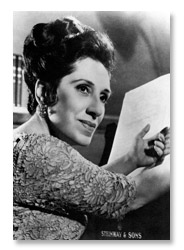 You’ve said that the Goldberg Variations are central to your life, and also that, to quote, you “don’t play this work as a tour de force, as a dazzling display of technique – I play it as a life experience.” What is it about the Goldberg Variations that initially attracted you to them, and why do you perceive this as one of the most important pieces you’ve performed?
You’ve said that the Goldberg Variations are central to your life, and also that, to quote, you “don’t play this work as a tour de force, as a dazzling display of technique – I play it as a life experience.” What is it about the Goldberg Variations that initially attracted you to them, and why do you perceive this as one of the most important pieces you’ve performed?
Like Mt. Everest: it is there! [5]
Glenn Gould cited you as an influence for his 1955 recording of the Goldberg Variations. Do you see any similarities between his first recording of this work and your performances of the same time period? What was your initial reaction to Gould’s infamous recording?
Only a good deal of my influence and of imitating literally what I do, without knowledge of why I do, or adequate attention to what Bach is doing in the structure of his music.
There has been scholarship on Bach’s music concerning symbolism, including Lutheran and Christian symbolism and numerology. Have you discovered a lot of symbolism in the Goldberg Variations? If so, have these discoveries influenced your performances of the Goldberg Variations?
Many can be found, but this practice should not be overdone or become dogma.
You are well-known not only as a performer, but as a philosopher. Your essay, “A Philosophy of Performance: Performance as an Art” concisely outlines your beliefs on performance and interpretation. What you say in there seems to be implied material: “The composer comes first, the performer second. The performer does not create a composition anew.” Have you had many encounters with people that disagree with this statement?
Some people can always be found who disagree with anything.
Also, what does this idea do to the notion of transcriptions or arrangements – do you feel that people are “damaging,” to use perhaps too strong of a word, the composer’s original ideas?
Some damage: a few don’t. This is like the work of translation.
Or do you see them as a way to spread music beyond the sphere it maintains?
Yes – sometimes necessary in the 19th century – NOT today.
What do you feel of treatments of Bach by Busoni and others? [6] Have you heard contemporary arrangements of the Goldberg Variations by pianists Jacques Loussier and Uri Caine? If so, what are your thoughts on them?
He (Jacques Loussier) is very clever and amusing – but these are not representative of great art.
Have you found it difficult to combine the individual variations into a complete whole? Has it been difficult to perfect the gestalt of the piece?
Never – this is the whole point of integrating a composition.
Are there any recordings or editions of the Goldberg Variations that you prefer?
Bach-Gesellschaft and Neue Bach-Ausgabe but I study Bach’s autographs or where they are lost, the best copies by the most reliable copyists of his time.
Many artists don’t like to listen to their recordings once they are finished with the process. Do you feel the same way, or do you review prior recordings before rerecording a piece?
It depends. I rely mostly on J.S. Bach! and not on opinions.
[1] John Ardoin, Great Pianists of the Twentieth Century: Rosalyn Tureck II, Philips Compact Disc 456 979-2; Jeremy Siepmann, Goldberg Variations, Deutsche Grammophon Compact Disc 289 456 599-2.
[2] In her response, Dr. Tureck underlined this section and the section in a later question. It is assumed that she did this to save her the time of rewriting those sentences, and that the underlined section is her answer to that question.
[3] “Just before my 17th birthday I had an experience which changed my life. I … was continuing to learn three (Bach preludes and fugues from the Well-Tempered Clavier) each week … when I suddenly lost consciousness …. When I came to, I had a whole new insight into Bach’s music. I suddenly understood that the realization of Bach’s structures in performance required a whole new way of thinking musical form and structure. I realized at that very same moment … that a totally new performance technique had to be created” (as quoted by Siepmann, p. 10).
[4] Dr. Tureck did not answer this question. Much has been written by and about Dr. Tureck and this debate. She has said “In respect to Bach and the performance media, Bach’s own practice was so often to recast the settings of his music for entirely different media …. I aim to embrace a more holistic Bach ….” (as quoted by Siepmann, p. 11).
[5] This is similar to the remark that Mrs. Nanette Lunde, a UW-Eau Claire music faculty member, made when I interviewed her about the Goldberg Variations.
[6] While studying with Jan Chiapusso at the age of 14, Dr. Tureck studied and compared the transcriptions of Busoni, Cortot and Liszt with Bach’s originals, although “neither Chiapusso nor I was interested in the virtuoso arrangements by Liszt” (as quoted by Siepmann, p. 10).
Single Petal of a Rose, by Duke Ellington:
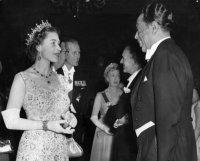 Single Petal of a Rose was written by Duke Ellington as part of his Queen's Suite in the late 1950s. Recorded in 1959, only one was copy was pressed, and given to Queen Elizabeth II. The recording was later released to the general public. (If I'm not mistaken, it was released after Ellington's death, but I can't find any confirmation on that.)
Single Petal of a Rose was written by Duke Ellington as part of his Queen's Suite in the late 1950s. Recorded in 1959, only one was copy was pressed, and given to Queen Elizabeth II. The recording was later released to the general public. (If I'm not mistaken, it was released after Ellington's death, but I can't find any confirmation on that.)
This was originally a duet for piano and bass, but is often played by a solo pianist. (The bass part adds to the overall piece, but is basically sustained notes during the two louder sections, with the flourishes in the right hand.)
I first played this piece as a freshman in college - November of 1999, on my first collegiate jazz concert. It was sort of a test piece my jazz band director, Robert Baca, gave to his pianists. I fell in love with it almost immediately (the great feedback from my first performance of it didn't hurt, either!). And while I love Duke, his music, his band, and his playing, my personal favorite recording of this piece is that done by Sir Roland Hanna:
I wanted to make a video of this for a long time (for both my mother, and at the request of one of my former students). I got a little time in one of the classrooms on campus tonight (and last night - hence my Shostakovich video), so voila!
Once again, thanks for listening!